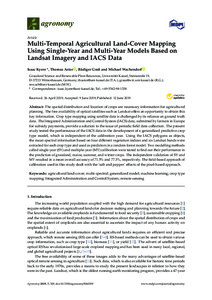Aufsatz

Multi-Temporal Agricultural Land-Cover Mapping Using Single-Year and Multi-Year Models Based on Landsat Imagery and IACS Data
Zusammenfassung
The spatial distribution and location of crops are necessary information for agricultural planning. The free availability of optical satellites such as Landsat offers an opportunity to obtain this key information. Crop type mapping using satellite data is challenged by its reliance on ground truth data. The Integrated Administration and Control System (IACS) data, submitted by farmers in Europe for subsidy payments, provide a solution to the issue of periodic field data collection. The present study tested the performance of the IACS data in the development of a generalized predictive crop type model, which is independent of the calibration year. Using the IACS polygons as objects, the mean spectral information based on four different vegetation indices and six Landsat bands were extracted for each crop type and used as predictors in a random forest model. Two modelling methods called single-year (SY) and multiple-year (MY) calibration were tested to find out their performance in the prediction of grassland, maize, summer, and winter crops. The independent validation of SY and MY resulted in a mean overall accuracy of 71.5% and 77.3%, respectively. The field-based approach of calibration used in this study dealt with the ‘salt and pepper’ effects of the pixel-based approach.
Zitierform
In: Agronomy Volume 9 / Issue 6 (2019-06-12) , S. 309 ; ISSN 2073-4395Förderhinweis
Gefördert durch den Publikationsfonds der Universität KasselZitieren
@article{doi:10.17170/kobra-20190910674,
author={Kyere, Isaac and Astor, Thomas and Graß, Rüdiger and Wachendorf, Michael},
title={Multi-Temporal Agricultural Land-Cover Mapping Using Single-Year and Multi-Year Models Based on Landsat Imagery and IACS Data},
journal={Agronomy},
year={2019}
}
0500 Oax 0501 Text $btxt$2rdacontent 0502 Computermedien $bc$2rdacarrier 1100 2019$n2019 1500 1/eng 2050 ##0##http://hdl.handle.net/123456789/11316 3000 Kyere, Isaac 3010 Astor, Thomas 3010 Graß, Rüdiger 3010 Wachendorf, Michael 4000 Multi-Temporal Agricultural Land-Cover Mapping Using Single-Year and Multi-Year Models Based on Landsat Imagery and IACS Data / Kyere, Isaac 4030 4060 Online-Ressource 4085 ##0##=u http://nbn-resolving.de/http://hdl.handle.net/123456789/11316=x R 4204 \$dAufsatz 4170 7136 ##0##http://hdl.handle.net/123456789/11316
<resource xsi:schemaLocation="http://datacite.org/schema/kernel-2.2 http://schema.datacite.org/meta/kernel-2.2/metadata.xsd"> 2019-09-10T15:26:33Z 2019-09-10T15:26:33Z 2019-06-12 doi:10.17170/kobra-20190910674 http://hdl.handle.net/123456789/11316 Gefördert durch den Publikationsfonds der Universität Kassel eng Urheberrechtlich geschützt https://rightsstatements.org/page/InC/1.0/ agricultural land-cover multi-spectral generaltized model machine learning crop type mapping Integrated Administration and Control System remote sensing 630 Multi-Temporal Agricultural Land-Cover Mapping Using Single-Year and Multi-Year Models Based on Landsat Imagery and IACS Data Aufsatz The spatial distribution and location of crops are necessary information for agricultural planning. The free availability of optical satellites such as Landsat offers an opportunity to obtain this key information. Crop type mapping using satellite data is challenged by its reliance on ground truth data. The Integrated Administration and Control System (IACS) data, submitted by farmers in Europe for subsidy payments, provide a solution to the issue of periodic field data collection. The present study tested the performance of the IACS data in the development of a generalized predictive crop type model, which is independent of the calibration year. Using the IACS polygons as objects, the mean spectral information based on four different vegetation indices and six Landsat bands were extracted for each crop type and used as predictors in a random forest model. Two modelling methods called single-year (SY) and multiple-year (MY) calibration were tested to find out their performance in the prediction of grassland, maize, summer, and winter crops. The independent validation of SY and MY resulted in a mean overall accuracy of 71.5% and 77.3%, respectively. The field-based approach of calibration used in this study dealt with the ‘salt and pepper’ effects of the pixel-based approach. open access Kyere, Isaac Astor, Thomas Graß, Rüdiger Wachendorf, Michael doi:10.3390/agronomy9060309 publishedVersion ISSN 2073-4395 Issue 6 Agronomy 309 Volume 9 </resource>
Die folgenden Lizenzbestimmungen sind mit dieser Ressource verbunden:
Urheberrechtlich geschützt

